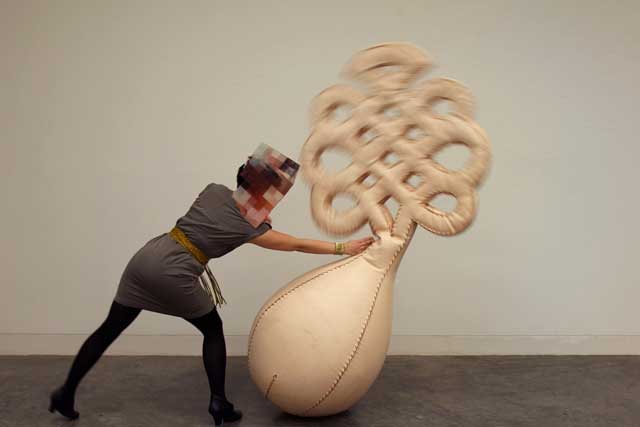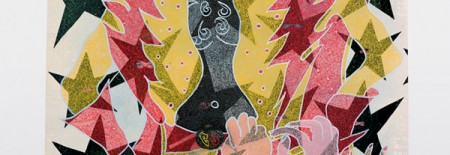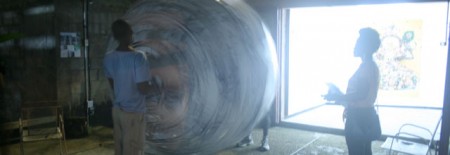If you hang out at any gathering of Canadian artists these days there is one topic that is sure to come up, government cut-backs on arts funding. How do we make the government care? Artists are getting serious about advocating on their own behalf, something I fully support, but nevertheless I wonder if we’re looking to the wrong place for answers.
What spurred this thinking was the Throw Down Art Forum organized by the Art Gallery of Greater Victoria at the Vancouver Island School of Art. Throw Down is an exhibition on at the AGGV that looks at how artists rise to the challenge of producing work in difficult circumstances and the one day Art Forum presented a series of talks and workshops that looked at our relationship with funding bodies. “Power Talks” from the Canada Council, BC Arts Council and CRD were combined with a key note by arts policy consultant Max Wyman and workshop on arts advocacy by Chris Creighton-Kelly and France Trepanier.
The presentations were all excellent. Here we had in one place a crash course on arts advocacy and getting access to government funding. Both Max’s key note and Chris and France’s workshop focused on presenting effective arguments for the arts, looking at both its intrinsic and extrinsic value. In short Art is transformational, both good for the soul and for the economy. Give us money.
But as much as I would like to see an increase in government funding to the arts, I’m convinced the arts community’s focus on this way of gaining resources is to our larger detriment. This is for two main reasons, which I’ll call the filter effect and the scarcity mentality.
Filter Effect
The Canada Council looms large over most contemporary artists in Canada. Over my career I’ve been a failed applicant, a successful applicant and a sat on the jury for one of their programs. The process of being judged by ones peers is about as fair as it can possibly be. Nevertheless the Canadian arts community’s focus on the Council (and it’s provincial counterparts that use the same adjudicating model) as the biggest source of funding and validation is problematic. It necessarily flattens what’s viable in the Canadian art scene.
In fact this results from the very fairness of the process. With funds for only a small number of applicants juries in effect operate on a consensus model. A low score by any single member of the jury will likely destroy your chances of getting funding. If only one person on the jury recognizes your genius, sorry, you don’t have a chance.[1] The cheque only gets written when everyone agrees. Although the results are usually excellent, a degree of group think can’t be avoided and some types of work aren’t going to make it. The problem is compounded by a sort of self-censuring by artists. If only on a subtle level we begin to apply for what we feel may get funded.
But even if we could fix the process to allow for more varied results (make it less fair?) and artists felt at complete liberty to apply to go wherever their inclination took them we are still left with the problem of scarcity.
Scarcity mentality
The bigger problem with looking to the government as the primary source of resources for the arts is that it supports a mentality of scarcity. There are many more artists in Canada than the Councils can fund and for every active artist there is probably another five that would be making work if they thought is was financially viable. The quest for Council dollars places us in a zero sum game where we all scramble for scarce resources and our view of what’s possible is limited by the criteria on a grant form.
Part of the problem lies in the artificial separation of work into ‘commercial’ and ‘non-commercial’ categories. While I’m thankful that there exists a place for art outside the market, by telling ourselves that our most compelling and challenging work should have no market value we are in essence saying that we’ll make due with what the government gives us. We are also inadvertently training the public to see no financial value in what we produce.
It’s a world of limited horizons that I find deeply ironic. For me art is the antithesis of scarcity. Part of it’s magic is how it makes something out of nothing – how mere material becomes something that feeds the soul. And as a society we’ve long since moved from a market of things to a market of ideas – and a thing only gains value from the ideas grafted onto it. How then can art that materializes our most meaningful ideas be without value?
I should say again that I’m very happy that the Canada Council and provincial and arts funders exist. Other places I’ve lived with little or no government funding face other serious challenges. But I’m not so happy with an arts community that seems to look at government grants as the only solution. While all heads are turned to Ottawa, we simply aren’t putting in enough energy to seeing other solutions and realizing other opportunities. The result is a heavily distorted art scene without enough collectors, philanthropists and business support, one where only a small segment of the population sees our value leaving us vulnerable to cries of elitism.
Oddly enough if we worked at building our constituency among the Canadian public at large, and with art buyers and private supporters we would also be building the constituency we need to lobby for better government support as well. If more people see the value in art, financial and otherwise we’ll all be better off.
[1] This is an oversimplification. A strong advocate for your work can in fact sway other jury members and similarly someone who gives a negative score may revise it in the face of positive scores by the remainder of the jury.






